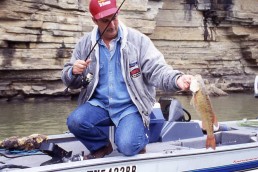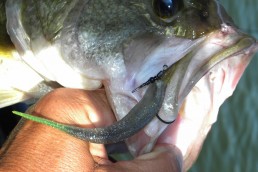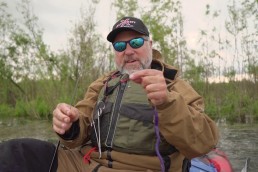Tempt Winter Bass with ‘Dessert’ to Earn Tough Bites
SHARE THIS POST
Finicky! That’s what largemouth and smallmouth bass can be in cold water. They don’t eat often because it takes a couple of days or more to digest a meal.
To get them to hit your bait, sometimes you must finesse them with “dessert.” You know, like when you’re full from a large meal, and you can still eat a small bowl of ice cream or an after-dinner mint. It’s the same with bass—you have to offer them something small and special.
Find them first
Most bass have moved to their wintertime hidey-holes on vertical to nearly vertical structures. They may or may not be closely associated with cover, but they will be close to structure (the bottom or shape of the bottom: points, humps, coves, etc., Cover is something on structure: rocks, stumps, weeds, an old tire, etc.).
Fish the shallow rocky areas close to deep water on a steep shoreline sheltered from the north wind. The water temperature will be a little warmer on the north shore, especially if there is wood or rock to absorb that sunshine. It may range from a few to as much as 10 degrees warmer. You are looking for a little higher temperature, just a few degrees warmer than you’ll find in the most of the lake. Rivers have pretty much a homogenous temperature because the current mixes the water. However, on a lake or river, look for objects that will absorb heat. Also check temperatures at creek mouths and farther upstream.
When you’ve found warmer water, cast your bait to shallow water and then work your way deeper. Experienced guides have said that there’s no reason to start fishing at sunrise in winter because the bass won’t become active until about 10 a.m.
The first thing to look for is baitfish. They move shallow to take advantage of the warmer water—then here come the bass.
One more tip where to find bass: If you know where they spawned last spring, they are likely to be on steep structure near that area, probably less than 100 yards away.
Are you enjoying this post?
You can be among the first to get the latest info on where to go, what to use and how to use it!
Small special something
Of all the small baits, the 1/16-ounce lead head with crawfish-colored hair and a 2- or 3-inch finesse grub on a 1/16- or 1/8-ounce lead head are good choices in cold water. The former is for working vertical drops and the latter is for working ledges, edges of flats and not-quite vertical structures.
The hair jig sinks slowly and its descent keeps the bait in the strike zone longer, tempting Ms. Bass beyond her endurance. You can add a small plastic trailer (a portion of a floating worm) for more buoyancy. Also, you can use a thick diameter line to add resistance to sinking, but if the water is clear, don’t go thicker than 8-pound-test. FireLine floats, so you may try it for a little extra buoyancy.
The lead head with a plastic grub crawled along rocky drops is almost impossible for bass to ignore. This bait works well where it will be in contact with the bottom rather than sinking slowly. A 1/8-ounce lead head produces more sound than the 1/16 ounce when it’s dragged along the structure and over cover.
Four- and 6-inch worms rigged Texas-style cast with a split shot about a foot in front of your hook is another excellent finesse bait. It can be made to sink slower than a hair jig by using a small weight—the weight determines descent. It can be used on vertical drops and crawled over cover.
If you want to finesse bass with crankbaits, you need to use smaller lures that impart their action at a slow retrieve. S-L-O-W is the wintertime rule. You may have to retrieve cranks at various depths until you locate the bass. Chances are that if you find bass at 12 feet, for instance, that’s the depth you’ll find other bass.
Whichever bait you prefer to cast, offer it temptingly. Keep it in the strike zone until the bass decides, Yes, I will have just one more bite for dessert.
MWO
SHARE THIS POST
Did you enjoy this post?
You can be among the first to get the latest info on where to go, what to use and how to use it!
Vernon Summerlin
For more than 30 years, Vernon Summerlin has produced outdoor articles and books that can be found on Amazon; most recently How to Analyze a Bass Hole: Think and Catch’em! He is the recipient of more than 40 awards for magazine and newspaper articles, TV, radio, photography and books.



